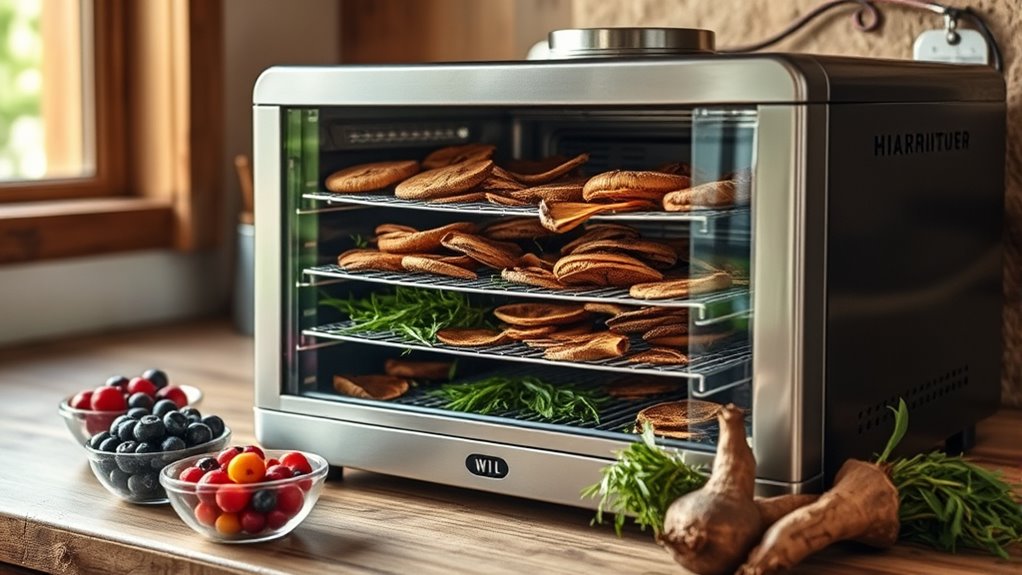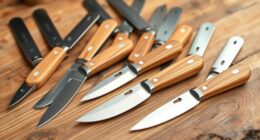When choosing a dehydrator for wild foods, focus on adjustable temperature controls for precise drying, so you prevent over or under-drying. Pick a size that matches your harvest volume to save time and energy. Good airflow ensures even dehydration and prevents mold, while easy-to-use controls make operation straightforward. Opt for trays that are easy to clean, and consider energy efficiency to reduce costs. Keep exploring to discover more tips for ideal wild food preservation.
Key Takeaways
- Precise temperature control and adjustable settings ensure even dehydration and preserve wild food flavors.
- Adequate size and tray design facilitate efficient processing of small to large harvests with easy cleaning.
- Effective airflow and ventilation prevent mold, promote uniform drying, and reduce drying times.
- Energy-efficient features like timers and eco-friendly options minimize environmental impact and operating costs.
- User-friendly interfaces, automatic timers, and data management tools simplify operation, especially for beginners.
Adjustable Temperature Settings for Precise Drying
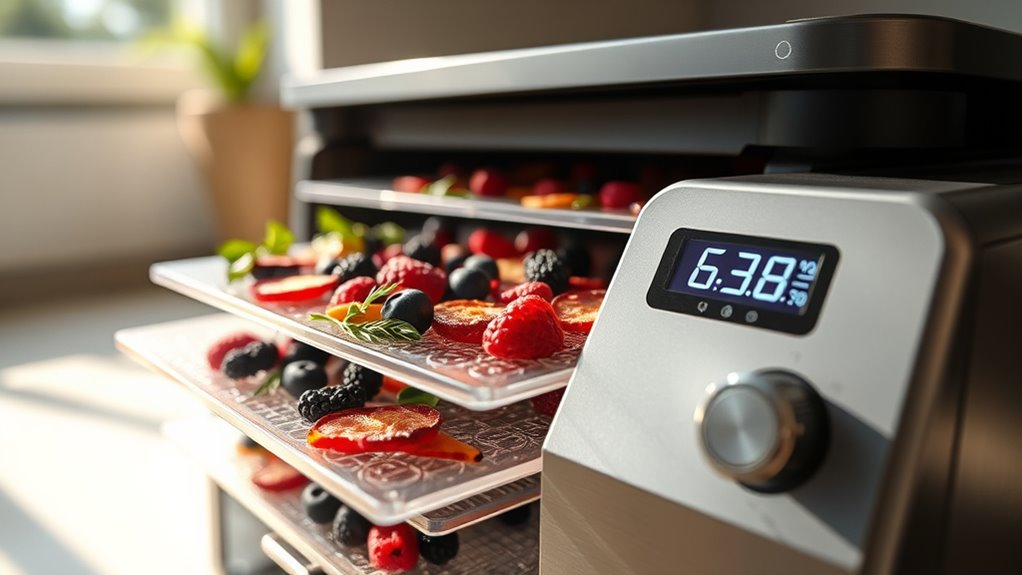
Adjustable temperature settings allow you to control the drying process more precisely, ensuring your food dehydrates evenly and retains its quality. By fine-tuning the temperature, you prevent over-drying or uneven dehydration that can compromise flavor preservation. This feature is especially important when working with wild foods, which often vary in moisture content and texture. It also helps keep noise levels manageable; lower temperatures typically produce less noise, making the dehydrator more pleasant to use in quiet environments. With adjustable settings, you gain better control over the entire process, resulting in fresher-tasting, nutrient-rich dried foods. Additionally, temperature control can extend the lifespan of your dehydrator by preventing overheating. Overall, this feature ensures you get consistent results while maintaining a peaceful, low-noise workspace.
Size and Capacity to Match Wild Food Batches
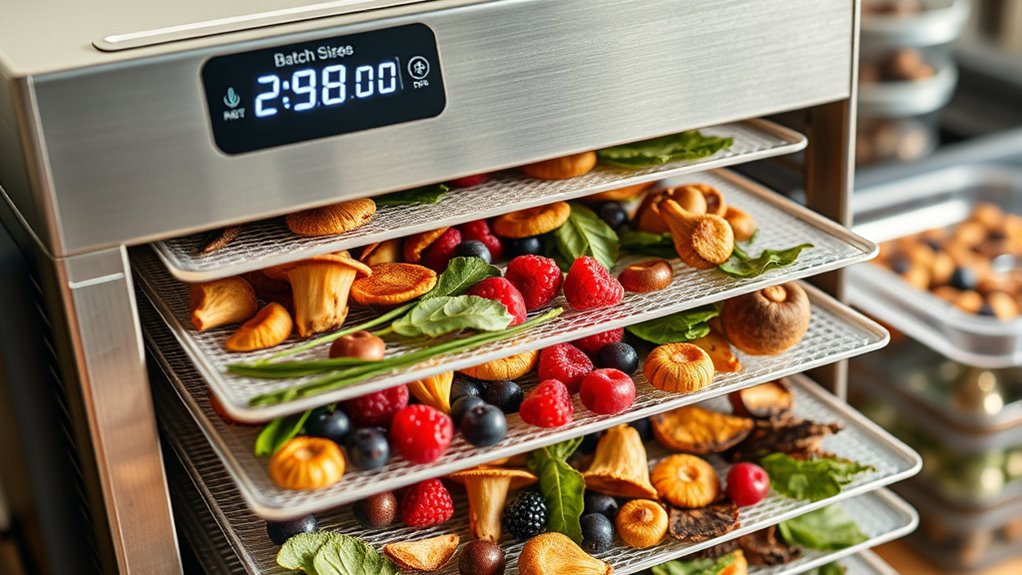
Choosing the right dehydrator depends on your wild food batch sizes. Smaller models are perfect for occasional or small harvests, while larger units handle bigger quantities efficiently. Consider your typical harvest volume to find a dehydrator that matches your needs without wasting space or capacity. Additionally, understanding the types of cookies used can help you manage privacy and optimize your browsing experience while researching dehydrators.
Dehydrator Size Options
Selecting the right dehydrator size is essential to efficiently process your wild food harvests without wasting space or energy. Smaller models are ideal if you typically dry small batches or have limited storage, ensuring food preservation without excess capacity. Larger units offer more room for bigger harvests, saving time during peak foraging seasons. Consider your typical batch size when choosing, as a too-small dehydrator may require multiple runs, while an oversized one could squander energy. Durability matters—sturdy construction ensures your dehydrator withstands frequent use and heavy loads. Matching your dehydrator size to your typical harvests can improve overall efficiency and help prevent unnecessary energy consumption. By matching the size to your needs, you optimize food preservation and ensure your dehydrator remains reliable over time. Proper sizing helps you get the most out of your wild food drying endeavors without unnecessary expense or effort.
Batch Processing Capacity
Matching your dehydrator’s capacity to your wild food batches is essential for efficient drying. A dehydrator with the right size prevents overcrowding, which can lead to uneven drying and mold growth. It also helps preserve flavor by allowing proper airflow. Consider these factors:
- Dehydrator size aligned with typical batch volume
- Adjustable racks for flexibility
- Larger capacity for big harvests
- Smaller units for occasional use
- Proper spacing to prevent mold and ensure even dehydration
- Selecting a dehydrator with Honda Tuning features can enhance airflow management and overall performance.
Choosing the right capacity minimizes the risk of mold, preserves the flavor, and makes batch processing more manageable. Overloading can cause uneven drying, while too small a unit wastes time and energy. Match your dehydrator’s capacity to your wild food harvest to optimize results.
Airflow and Ventilation Efficiency
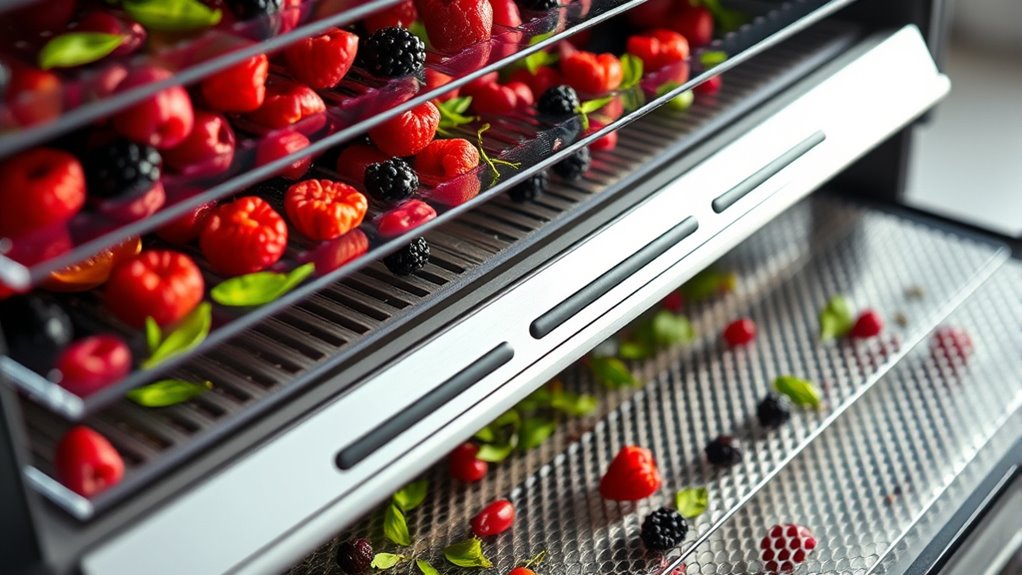
Optimizing airflow design guarantees your dehydrator dries food evenly and efficiently. A well-structured ventilation system can substantially improve air circulation and reduce drying time. Focusing on these factors helps you get better results with less energy use. Additionally, ensuring that the airflow system minimizes temperature fluctuations enhances consistent dehydration performance.
Airflow Design Optimization
Effective airflow design is essential for maximizing dehydration efficiency, as it guarantees consistent circulation of dry air throughout the unit. Optimizing airflow helps prevent uneven drying and preserves the quality of wild foods. To enhance airflow, consider integrating features like adjustable vents and strategically placed fans. Using moisture sensors allows you to monitor humidity levels precisely, ensuring ideal conditions without wasting energy. Solar power options can make your dehydrator more eco-friendly by harnessing renewable energy, reducing operational costs. Proper airflow design also involves thoughtful placement of air intake and exhaust ports, promoting uniform drying. By focusing on these elements, you’ll achieve faster, more consistent results while conserving energy and maintaining food quality. Proper airflow management is crucial for preventing mold and spoilage in dehydrated foods.
Ventilation System Effectiveness
Have you ever wondered how well-ventilated your dehydrator truly is? Effective ventilation ensures proper airflow, which directly impacts humidity control. If airflow isn’t consistent, excess moisture can linger, leading to uneven drying or spoilage. Look for models with good ventilation systems that promote steady airflow without creating excessive noise levels. A quiet dehydrator helps you monitor your wild foods comfortably, especially during long drying sessions. Proper ventilation also prevents the build-up of humidity inside the unit, maintaining ideal drying conditions. When evaluating dehydrators, prioritize those with efficient airflow designs that balance quiet operation and humidity control. Ensuring airflow efficiency is crucial for uniform drying and preserving the quality of your wild foods without unnecessary noise or moisture issues.
Drying Time Reduction
Improving airflow and ventilation efficiency can substantially reduce drying times in your dehydrator. Faster drying preserves more nutrients and enhances flavor retention, making your wild food preservation techniques more effective. To maximize airflow, consider the following:
- Use dehydrators with adjustable vents for better air circulation
- Ensure even spacing of food slices to prevent blockages
- Clean vents and fans regularly for maximum efficiency
- Choose models with multiple fans for enhanced airflow
- Position your dehydrator in a well-ventilated area to promote consistent drying
- Incorporate proper airflow management techniques to optimize dehydration speed and quality
These adjustments help cut down drying time while maintaining quality. Efficient airflow not only speeds up the process but also minimizes the risk of spoilage, ensuring your wild foods are preserved with optimal flavor and texture.
Ease of Use and Control Options
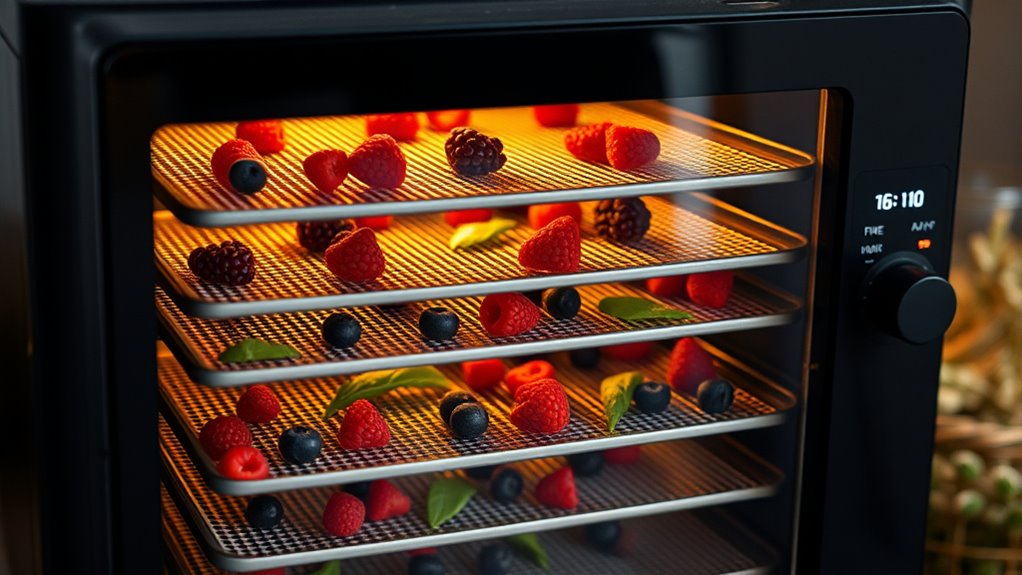
When choosing a dehydrator, ease of use and control options play a crucial role in ensuring a hassle-free experience. Digital controls make it simple to set and adjust temperature and drying times accurately, saving you time and frustration. Look for models with preset programs designed for specific foods or drying conditions; these simplify the process by automatically adjusting settings for ideal results. A user-friendly interface, such as clear displays and intuitive buttons, helps you operate the dehydrator confidently. Some dehydrators even offer timers that turn off automatically, preventing over-drying. Overall, these features make dehydrating wild foods straightforward, especially if you’re new to the process, allowing you to focus on gathering and preparing your bounty without technical distractions. Additionally, understanding data management through features like smart controls can enhance your drying process by providing real-time feedback and adjustments.
Tray Material and Design for Easy Cleaning
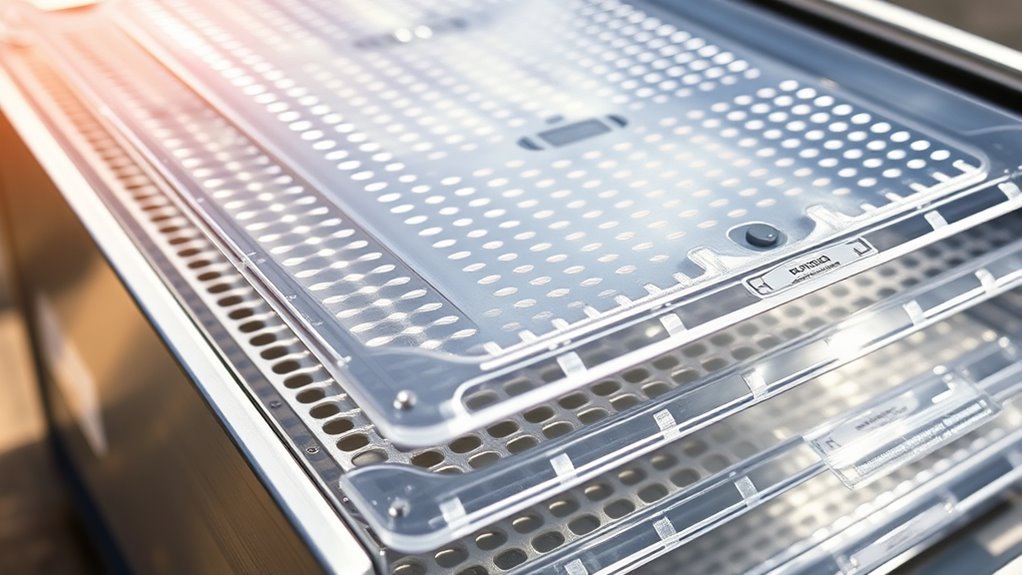
Choosing dehydrator trays made from materials that are easy to clean can substantially simplify your drying routine. The tray material and cleaning design directly impact how quickly and effortlessly you can maintain your dehydrator. Look for trays made from non-stick, dishwasher-safe materials like silicone or BPA-free plastics, which resist residue buildup. Consider trays with smooth, flat surfaces that prevent food particles from getting trapped. Removable trays with minimal crevices or ridges make cleaning faster. Some designs feature raised edges for spill prevention, but check if they’re still easy to wipe down. Choosing trays with simple, straightforward cleaning designs helps keep your dehydrator hygienic and ready for your next batch of wild foods. Enhanced natural language processing in modern designs can also improve user interaction and maintenance instructions.
Energy Consumption and Power Efficiency
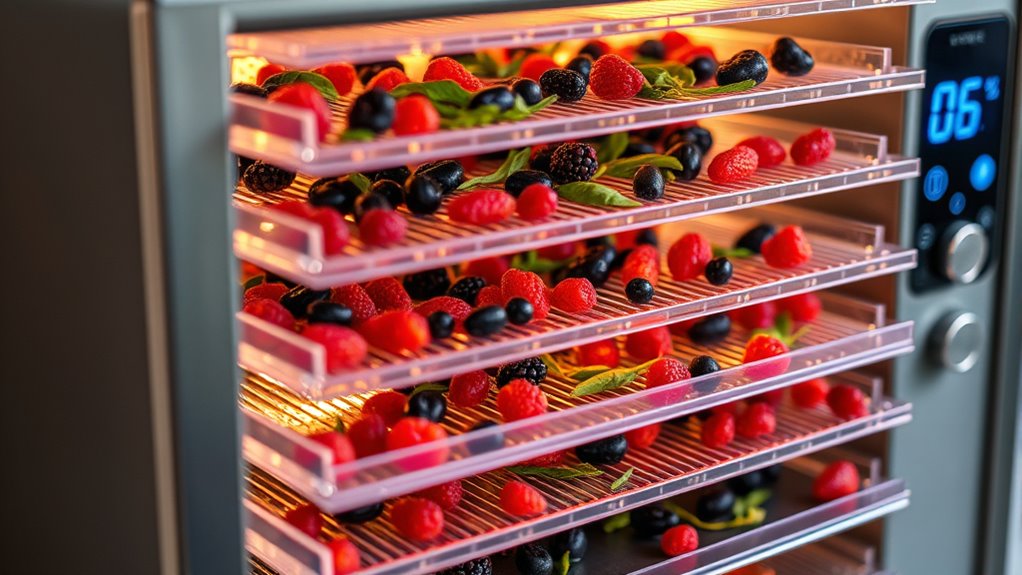
Energy consumption and power efficiency are essential factors to contemplate when selecting a dehydrator, as they directly affect your long-term operating costs and environmental impact. Look for models that incorporate energy-saving features, such as adjustable temperature settings and timers, to optimize power use. Solar power dehydrators are an eco-friendly option, harnessing renewable energy to reduce electricity needs. If you prefer more control and independence, manual operation dehydrators that don’t rely on electricity can be highly efficient, especially during off-grid adventures. Consider how often you’ll use the dehydrator and the size of your batches. Choosing a model with good power efficiency not only saves money but also minimizes your carbon footprint, making your wild food preservation more sustainable.
Frequently Asked Questions
Can Dehydrators Preserve the Flavor and Nutrients of Wild Foods Effectively?
You’re wondering if dehydrators can effectively preserve the flavor and nutrients of wild foods. The answer is yes, if you choose a dehydrator with precise temperature controls and even airflow. These features help maintain flavor retention and nutrient preservation by drying foods gently and uniformly. By avoiding excessive heat, you guarantee your wild foods retain their natural taste and nutritional value, making your dried wild foods both delicious and healthy.
Are There Specific Safety Features to Prevent Over-Drying or Spoilage?
Did you know that improper dehydration can cause up to 30% nutrient loss? To prevent this, you need dehydration units with over drying prevention and spoilage safeguards. These safety features make certain your wild foods don’t become over-dried or spoil, maintaining flavor and nutrients. Look for models with automatic shut-off or humidity controls, so you can enjoy safe, high-quality dried wild foods every time without worry.
How Long Does It Typically Take to Dehydrate Different Wild Foods?
You’ll find that dehydration times vary depending on the wild food and your dehydrator’s capacity. Smaller pieces dry faster, while larger ones take longer. With an adjustable temperature feature, you can fine-tune the process for different foods, guaranteeing ideal preservation without over-drying. Typically, fruits might take 6-12 hours, while herbs or greens need less. Check your dehydrator regularly to avoid spoilage and ensure perfect results.
Can Dehydrators Handle Irregularly Shaped or Large Wild Food Items?
You might think dehydrators struggle with irregularly shaped or large wild foods, but many models prove otherwise. Their capacity and adjustable drying racks let you handle diverse sizes and shapes efficiently. By choosing a dehydrator with ample capacity and flexible racks, you can evenly dry large or oddly shaped items without hassle. This setup guarantees thorough dehydration, making it easier to preserve your wild foods perfectly every time.
What Maintenance Is Required to Keep the Dehydrator Functioning Optimally?
To keep your dehydrator working effectively, you should regularly clean filters and check vents for dust or blockages. This maintenance prevents overheating and guarantees even drying. Wipe down removable parts with warm, soapy water and inspect vents to remove any debris. Doing this weekly helps your dehydrator run efficiently, extends its lifespan, and guarantees your wild foods dry uniformly without unwanted mold or spoilage.
Conclusion
Think of choosing a dehydrator as selecting a trusty compass for a wilderness trek. Just as a reliable compass guides your way, the right features—like precise temperature control, ample capacity, and efficient airflow—steer you toward successful wild food preservation. With the proper tool in hand, you’ll navigate the drying process smoothly and confidently, transforming nature’s bounty into lasting nourishment. Trust in these features, and your wild food journey becomes a well-charted adventure.

